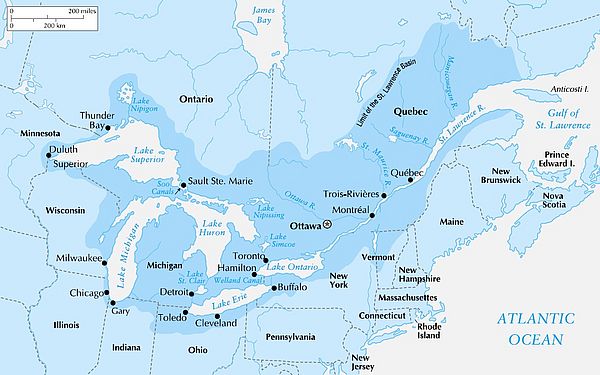For a brief period in 1998, the United States government officially recognized Lake Champlain as one of the Great Lakes. The designation allowed Vermont institutions access to funds reserved for states which bordered an ocean or a Great Lake, but Midwestern officials were outraged that Champlain might share a designation with their lakes. After much media attention and hyperbole Congress rewrote the designation, and Lake Champlain reverted to a great lake while retaining the funding opportunities.
Despite being the ninth largest freshwater lake in the United States, Champlain is still substantially smaller than any of the Great Lakes. By surface area, almost 17 Champlains would fit into Ontario, the smallest of the Great Lakes. By water volume, almost 19 Champlains would fit into Lake Erie, which contains less water than Ontario. Only in depth does Champlain come close to the Great Lakes, topping shallow Lake Erie in both maximum and average depth.
Aside from the legal ramifications of a Great Lake designation for Champlain, what geographical or ecological considerations link the water bodies? By virtue of sitting on similar latitudes, the Great Lakes and Champlain share similar watershed ecosystems, dominated by deciduous forests, and seasonal climates. The systems have similar origins, both having been carved by glaciers from pre-existing riverbeds. The systems even have a hydrologic connection through the New York State Canal system, which has allowed many of the invasive species that arrive in the Great Lakes on commercial ships to eventually reach Champlain.
Additionally, both systems drain to the St. Lawrence River, so it would seem they could be considered part of the same watershed. Yet, when the Great Lakes Commission, a bi-national entity similar to the Lake Champlain Basin Program, outlined their position regarding adding Lake Champlain to the Great Lakes, one of their principal lines of reasoning noted that Champlain was, “outside the Great Lakes Basin”. So, do Lake Champlain and the Great Lakes share a watershed?
The simple definition of a watershed is the area of land that collects water which drains to a particular water body. By this definition, all land is located within some watershed. The size of a watershed depends on which drainage point is referenced.
Watersheds are like Russian matryoshka dolls, small ones nestled inside larger ones. When defining a Basin, like the Lake Champlain Basin or the Great Lakes Basin, it’s as if one is attempting to define the largest doll. Within the Lake Champlain Basin lie the smaller dolls of the Saranac River Basin, the Winooski River Basin, the Ausable River Basin, and many others. Each of these in turn could be separated into yet smaller basins. However, the St. Lawrence River Basin would be a larger doll that encompasses both the Great Lakes and Champlain Basins. And the Atlantic Ocean drainage would be larger again.
People are usually most concerned about waterbodies with which they are most familiar, the places where they swim, fish or boat. Hence, someone in Lake Placid might express more interest in the Lake Placid watershed than the Lake Champlain watershed even though the one is nestled within the other. And residents of the Midwest are more concerned about a Great Lakes watershed than the larger St. Lawrence River watershed we share with them. Truth be told, advocates for Lake Champlain are more likely to be concerned about the Lake Champlain watershed than the larger St. Lawrence River watershed too.
However, narrow focus makes managing larger watersheds difficult. Problems in the receiving body seem distant and remote to those nestled in smaller areas that appear clean. An extreme example occurs in the Gulf of Mexico, where a large area of nutrient enrichment has created a “Dead Zone”, yet the source of the nutrients might be far upstream in the heart of the country along the Mississippi River drainage.
On the plus side however, when an emotional attachment to a local water body energizes more people, focus on smaller watersheds has positive downstream affects. Numerous tree plantings and volunteer activities have been conducted throughout the Lake Champlain Basin by people who wanted to help their nearby river, but the lake those rivers feed benefits too. Similarly, allowing institutions in the Lake Champlain watershed to utilize resources previously reserved for the Great Lakes has increased the breadth and diversity of ideas and research brought to bear on Great Lakes issues. And these ideas can be transferred further downstream to improve the St. Lawrence River too.
Water is a resource that links people across broad geographic spans. Whether the watershed is that of a Great Lake or a small pond, the water eventually passes through en route to another community. Wherever you wander on earth, you are in a watershed. Treat it with care and affection.
